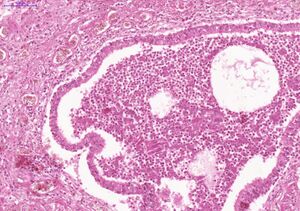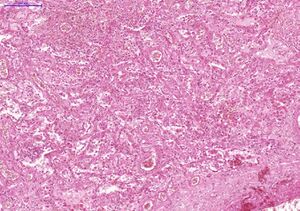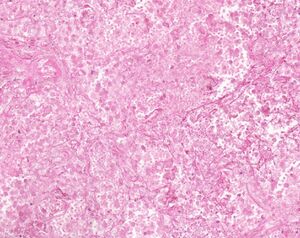4. Hemorrhagic infarct of the lung: Difference between revisions
Created page with "'''Staining:''' HE '''Organ''': Lung '''Description''': In the middle of the slide you can see an artery that is blocked by a red-colored embolus. We can see a kinda cake-piece-shaped area from the embolus to the bottom corner that is more eosinophilic than the rest of the slide. Zooming in on the eosinophilic part shows lack of nuclei, presence of RBCs, eosinophilia and loss of cell structure. Along the lower right side of the triangle there is a very dark red part,..." |
No edit summary |
||
| Line 1: | Line 1: | ||
'''Staining:''' HE | [[File:Haemorrhagic infarct of the lung overview.jpg|thumb|Overview]]'''Staining:''' HE | ||
'''Organ''': Lung | '''Organ''': Lung | ||
| Line 9: | Line 9: | ||
On the top part of the slide we can see normal lung tissue. The area between the normal lung tissue and the necrotic part has neutrophils inside the alveoli. | On the top part of the slide we can see normal lung tissue. The area between the normal lung tissue and the necrotic part has neutrophils inside the alveoli. | ||
'''Diagnosis''': Haemorrhagic infarct of the lung | '''Diagnosis''': Haemorrhagic infarct of the lung[[File:Haemorrhagic infarct of the lung bronchiole.jpg|thumb|This picture shows a bronchiole. It contains many granulocytes.]]'''Theory''': | ||
'''Theory''': | |||
The embolus is red in this case because it originates from a vein. The lung tissue around the necrosis is atelectatic, meaning that the alveoli are collapsed so they contain very little volume. This is because of infarct pneumonia, the inflammation caused by bacteria that grow around and in the infarct. If this is not treated and the patient survives, there will be gangrene formation. | The embolus is red in this case because it originates from a vein. The lung tissue around the necrosis is atelectatic, meaning that the alveoli are collapsed so they contain very little volume. This is because of infarct pneumonia, the inflammation caused by bacteria that grow around and in the infarct. If this is not treated and the patient survives, there will be gangrene formation. | ||
| Line 18: | Line 16: | ||
Left-sided heart failure is a risk factor for lung infarction, as it causes congestion of the pulmonary circulation. When a branch of the pulmonary artery is then blocked by an embolus will the venous blood flow back into the lung, causing the haemorrhage. | Left-sided heart failure is a risk factor for lung infarction, as it causes congestion of the pulmonary circulation. When a branch of the pulmonary artery is then blocked by an embolus will the venous blood flow back into the lung, causing the haemorrhage. | ||
[[File:Haemorrhagic infarct of the lung pneumonia.jpg|thumb|Area with pneumonia. White blood cells can be seen.|left]] | |||
[[File:Haemorrhagic infarct of the lung infarct.jpg|thumb|Infarcted part. Note the absence of nuclei and presence of RBCs.]] | |||
[[File:Haemorrhagic infarct of the lung pneumonia.jpg | |||
[[File:Haemorrhagic infarct of the lung infarct.jpg | |||
[[Category:Pathology 1 - Histopathology slides]] | [[Category:Pathology 1 - Histopathology slides]] | ||
Latest revision as of 11:12, 5 July 2024

Staining: HE
Organ: Lung
Description:
In the middle of the slide you can see an artery that is blocked by a red-colored embolus. We can see a kinda cake-piece-shaped area from the embolus to the bottom corner that is more eosinophilic than the rest of the slide. Zooming in on the eosinophilic part shows lack of nuclei, presence of RBCs, eosinophilia and loss of cell structure. Along the lower right side of the triangle there is a very dark red part, made red by RBCs.
On the top part of the slide we can see normal lung tissue. The area between the normal lung tissue and the necrotic part has neutrophils inside the alveoli.
Diagnosis: Haemorrhagic infarct of the lung

Theory:
The embolus is red in this case because it originates from a vein. The lung tissue around the necrosis is atelectatic, meaning that the alveoli are collapsed so they contain very little volume. This is because of infarct pneumonia, the inflammation caused by bacteria that grow around and in the infarct. If this is not treated and the patient survives, there will be gangrene formation.
The outcome of pulmonary embolization differs based on which pulmonary vessel is blocked. If the pulmonary trunk is blocked, there is total embolization which always causes death. If a pulmonary artery is blocked there is subtotal embolization, and the consequence is almost always death. The most normal case however, which is not usually associated with death, is the partial or segmental embolization, where a segmental branch of the pulmonary artery is blocked. A fourth type is called microembolization, caused by a disease called DIC (disseminated intravascular coagulopathy).
Left-sided heart failure is a risk factor for lung infarction, as it causes congestion of the pulmonary circulation. When a branch of the pulmonary artery is then blocked by an embolus will the venous blood flow back into the lung, causing the haemorrhage.


